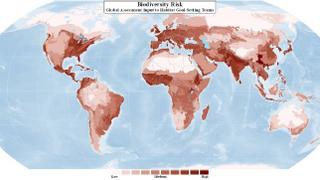
For the last two weeks we've been talking about global biomes in class and the timing is uncanny given the efforts of international conservation NGO's, TNC included. "The 2015 goal" as it's been called seeks to conserve 10 percent of all biomes on earth. Now this might seem ambitious but you have to consider that some global biomes have a decent amount of protection - maybe somewhere in the range of 20-30% which is considered by some enough to maintain ecosystem viability over the long term. But in order to determine where you go next require prioritization beyond just what is underrepresented by protected areas.
The major biome types that Liam discussed in class have been applied wholesale to WWF Ecoregions. For example the entirety of the California central coast ecoregion is classified as Mediterranean forests and woodland and Mojave desert would be considered deserts and xeric shrublands. These biomes are then aggregated in realms i.e. Nearartic This type of GIS representation has its issues - MAUP for example, but there's a real need for spatial explicitness.
In order to prioritize amongst these biomes there are four considerations: biological significance, habitat condition, biodiversity risk, and enabling conditions. Each of these elements has a whole list of assumptions and input data sets. For example biological significance is based on the WildFinder database (lists number and species by taxa per ecoregion ), wide ranging intact large mammal assemblages, and areas with mammal migrations. The initial model combines all four of the above elements to rank ecoregions and thus biomes. This is a really hard thing to do because no one wants to admit that the ecoregion they may be responsible for is not worth conserving.
My role in this effort has been to take a deeper look at just the Mediterranean biome types. The idea being the global assessment identifies med biomes as high priority so now what? If conservation has a dollar to spend, where do you put it? Europe is impacted and so is Southern California. But Baja and South Africa may provide viable alternatives. I spent all day today discussing a framework for this decision making that builds on the global effort but makes considerations specific for med type biomes. Like fragmentation for example. Our text mentions that speciation in the med basin of Europe may be driven by a high degree of fragmentation. So how do you tweak the dial on the habitat condition component to account for this?
At this point there are more questions than answers. I'm looking forward to getting more familiar with these med geographies, South Africa, Australia, Europe, Chile. The best part is congruence between school and work, it makes me secure in the relevancy of geography as a discipline.
1 comment:
Usually search for brand new alternatives. The FDA continues to be authorising new medications for several conditions linked to arthritis. When the medicine that you are at the moment using is not really working for you, always look if a new challenge has come out on the market which may operate much better. [url=http://www.x21w12w21.info]Ca45yhhe[/url]
Post a Comment